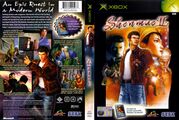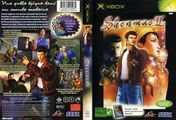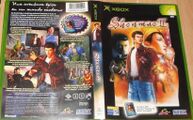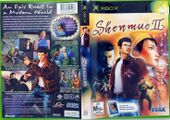Shenmue II
From Sega Retro
| Shenmue II | |||||||||||||||||||||||||||||||||||||||||||||||||||||||||||||||||||||||||||||||||||||
|---|---|---|---|---|---|---|---|---|---|---|---|---|---|---|---|---|---|---|---|---|---|---|---|---|---|---|---|---|---|---|---|---|---|---|---|---|---|---|---|---|---|---|---|---|---|---|---|---|---|---|---|---|---|---|---|---|---|---|---|---|---|---|---|---|---|---|---|---|---|---|---|---|---|---|---|---|---|---|---|---|---|---|---|---|---|
| System(s): Sega Dreamcast, Xbox | |||||||||||||||||||||||||||||||||||||||||||||||||||||||||||||||||||||||||||||||||||||
| Publisher: Sega Corporation (JP) Sega Europe (EU) Sega of America (US) | |||||||||||||||||||||||||||||||||||||||||||||||||||||||||||||||||||||||||||||||||||||
| Developer: Sega-AM2 | |||||||||||||||||||||||||||||||||||||||||||||||||||||||||||||||||||||||||||||||||||||
| Supporting companies: 81 Produce, Aoni Production (voice acting), Compozila, Jungle | |||||||||||||||||||||||||||||||||||||||||||||||||||||||||||||||||||||||||||||||||||||
| Distributor: Microsoft | |||||||||||||||||||||||||||||||||||||||||||||||||||||||||||||||||||||||||||||||||||||
| Peripherals supported: Jump Pack, Visual Memory Unit, Dreamcast VGA Box | |||||||||||||||||||||||||||||||||||||||||||||||||||||||||||||||||||||||||||||||||||||
| Genre: FREE Full Reactive Eyes Entertainment[1], Action RPG[2], Adventure[3] | |||||||||||||||||||||||||||||||||||||||||||||||||||||||||||||||||||||||||||||||||||||
| Number of players: 1 | |||||||||||||||||||||||||||||||||||||||||||||||||||||||||||||||||||||||||||||||||||||
| Official in-game languages: | |||||||||||||||||||||||||||||||||||||||||||||||||||||||||||||||||||||||||||||||||||||
|
Shenmue II (シェンムー II) is the direct sequel to Shenmue produced and directed by Yu Suzuki and developed by Sega-AM2. It was originally released for the Sega Dreamcast in 2001 and later the Xbox. Due to exclusivity rights obtained by Microsoft, the Dreamcast version of the game was not released in North America, although had been pencilled in for a release on the 4th December 2001.
Contents
Story
Shenmue II begins shortly after the first installment concluded. While Shenmue told the story of the first chapter of the saga, the second game tells the story of the third, fourth, and fifth chapters. It is possible that at one point, each chapter would receive its own game, however it was likely condensed due to the ambitious scope of the project, and poor Western sales of the first game.
Shenmue II skips the second chapter of the story, detailing events of Ryo Hazuki's trip from Yokosuka to Hong Kong. It was originally released as a comic book (available as an extra in the Xbox version of the game) is only briefly mentioned during the beginning of the game. Instead, Shenmue II starts at the third chapter of the saga, when Ryo has just arrived in Hong Kong.
Following the events of the first game Ryo has travelled to Hong Kong in order to locate Master Lishao Tao. After a difficult search, Ryo finally meets Master Lishao Tao, a woman named Xiuying; but she is unwilling to assist him in what she considers an immoral quest for vengeance. The two part ways, although Xiuying continues to monitor Ryo's progress and they continue to meet on occasion. Through his continued search, Ryo discovers another individual who may be able to assist him in locating Lan Di.
The fourth chapter of the saga takes place in Kowloon, as Ryo attempts to locate Yuanda Zhu; a martial arts expert who sent Iwao Hazuki a letter warning of his impending murder, a warning that arrived too late. At this juncture, several confrontations ensue between Ryo and his allies and the dangerous Yellowheads organization, who are aiming to kidnap Yuanda Zhu on behalf of Lan Di.
The fifth chapter takes place in Guilin. Shortly after arriving, Ryo encounters a young woman named Ling Shenhua. She had previously appeared to Ryo through several dreams throughout the first chapter of the series. As the two converse, it is revealed that the Shenhua family is connected with the legacy of the dragon and phoenix mirrors. Shenhua leads Ryo to a stone quarry on the outskirts of the village to meet with her father, but he is nowhere to be found. The episode comes to an ambiguous end when the pair discover a cryptic note and sword, which Ryo combines with the phoenix mirror and unwittingly sets off a device revealing a huge depiction of the two mirrors. At the game's cliffhanger ending, the sword is seen to float in mid-air.
Gameplay
Shenmue II and its predecessor, Shenmue were originally planned to be released as one, singular game before a decision was made to split the project in two in early 1999. As such, Shenmue II features very similar gameplay and shares many of the same assets as Shenmue, and implements many of the features once planned for the original game.
If given a Shenmue save file, the Dreamcast Shenmue II will continue where the player left off in the last game, carrying over any items, the current date (Shenmue starts in November 1986, but ends depending on how fast the player completes his/her quest) and any helpful statistics. While the series was effectively "cancelled" before getting to this point, the original idea was that events may change depending on the choices made in preceeding games. One example is that some optional fighting moves could only be learned in the original Shenmue, and would in theory be inaccessible to those starting from Shenmue II.
This situation is known to have caused some problems, particularly with the Xbox port which has no way of communicating with the first game. As such, blank Shenmue II save files generally have all the items and moves from the first game already set up, including items which serve no practical purpose (which can be therefore be sold for quick cash). Furthermore the game is region locked, in the sense that a Japanese Shenmue save file will not work with a European copy of Shenmue II and vice versa. This can be overcome with external utilities.
Shenmue II is estimated to be roughly five times bigger than the first game[20], with Ryo spending most of his time in the regions of Wan Chai and Kowloon in Hong Kong. Money plays a greater role, with Ryo initially being charged per night to stay at a hotel. Unlike the first game, all jobs are part-time, and money can also be earned through gambling (or by selling items in pawn shops). Ryo can also buy maps for areas of the game, which cause a minimap to display in the bottom left corner of the screen (another feature once planned for the first game).
Far more NPCs exist in Shenmue II, although far fewer are programmed with daily routines like the first game. Also, while Ryo can still talk to everyone, some character voices (and lines of dialogue) are shared. When an event requires Ryo be at a location in a set time, the player can often choose a "wait" option, which causes the clock to speed up (as opposed to the first game, where the clock speed is always constant).
QTE segments are similar to the first game, but now may ask for a sequence of buttons to be pressed in quick succession. "Free battle" only differs by showing enemy health bars (though Ryo will learn new moves as the adventure progresses). There are some different mini-games, including the addition of OutRun and After Burner II arcade machines in addition to Hang-On and Space Harrier.
Shenmue II provides a better workout for the touted "Magic Room" system, a mechanism invented by AM2 to procedually generate hundreds of building interiors which Ryo can visit. Advertised as a feature of the first game (though likely unused there), the algorithm attempts to create realistic room layouts, placing furniture in logical places and saving the development team from having to model each room by hand.
Should the user decide to carry data over from the original Shenmue, they will find that few decisions made in the original game will effect Shenmue II's story. The starting date can lead to differences in weather, and the number of pawnable items and money can assist when the story requires Ryo to have funds, but the core gameplay does not change in any meaningful way. It may even be beneficial to start with a brand new save, as then Ryo will have more fighting moves.
At one point in Shenmue two photographs of Ryo and Nozomi standing together are taken at two different distances apart. The player can decide which one to keep, and the chosen photo will be shown to Shenhua later in Shenmue II. The choice has no further influence on the game (Ryo's canonical decision was to keep the photo where the two were closer).
Unlike the original Shenmue, Shenmue II on the Dreamcast does not have an English voice dub, instead relying on the Japanese voice cast with added subtitles. The Xbox version adds an English dub, which has since been retroactively added the Dreamcast version through fan-made patches.
In the Xbox version, colour filters can be applied at any time to emulate a monochrome or sepia-toned look.
History
Development
- Main article: Shenmue II/Development.
Versions
In the European Dreamcast version of Shenmue II, some religious references were taken out and an answering machine message with sexual connotations was removed. Additionally, the character of Yuan, a cross-dressing male in the Japanese version, was made female and re-dubbed by a Japanese voice actress.
The Xbox version brings a number of technical changes to the game, such as the inclusion of quincunx anti-aliasing to create a cleaner image (however, the Dreamcast's VGA output leads to a shaper image than the Xbox). Texture mip-mapping is also employed with trilinear texture filtering, something absent in the Dreamcast release and all of Sega AM2's previous 3D games. Some textures were also replaced with higher quality versions, most notably Ryu's jacket, and some models are rendered with more polygons, again including Ryo.
Water texturing has been completely re-worked for the Xbox port to create a a more lifelike appearance, however the addition of bloom lighting is more controversial, often giving characters a "glow" in some daylight scenes. At night, however, the effect allows for more realistic neon signs and other lighting effects. Extra motion blur was also added to fight scenes.
Many textures in the Xbox version were changed, and in some cases, background geometry is simplified. All of the in-game jukeboxes are now Rock-Ola branded (as opposed to just "Rock"), and while some texturing errors were fixed (such as one of the OutRun logos being rendered backwards on the playable deluxe cabinet), others have been introduced, or removed entirely. Many of the "glass" textures are missing in the Xbox version for unknown reasons.
In the Xbox version, buildings can also cast shadows, which means the player's own shadow is often not rendered. Curiously the white button on the Xbox controller can be used to apply different visual filters, creating a more cinematic tone should the player desire, while the black button can be used to take screen shots of the game, which are then saved to the Xbox hard drive. The hard drive also plays its part in reducing load times.
The Xbox version of Shenmue II hits 30FPS more consistently than its Dreamcast counterpart, which often dips to 20FPS in more demanding scenes. Dolby Digital 5.1 is also used in select cutscenes, though the majority of the game still operates in stereo.
While supported by the Xbox 360 as a backwards-compatible title, the emulation is not perfect, with performance dips manifesting at certain parts of the game and shadows not rendering at all. Post processing effects such as the aforementioned bloom lighting and motion blur are missing. The visual filters also do not work, simply resulting in the game momentarily pausing.
Production credits
- Main article: Shenmue II/Production credits.
Magazine articles
- Main article: Shenmue II/Magazine articles.
Promotional material
- Main article: Shenmue II/Promotional material.
Artwork
Physical scans
Dreamcast version
| Sega Retro Average | |||||||||||||||||||||||||||||||||||||||||||||||||||||||||||||||||||||||||||||||||||||||||||||||||||
|---|---|---|---|---|---|---|---|---|---|---|---|---|---|---|---|---|---|---|---|---|---|---|---|---|---|---|---|---|---|---|---|---|---|---|---|---|---|---|---|---|---|---|---|---|---|---|---|---|---|---|---|---|---|---|---|---|---|---|---|---|---|---|---|---|---|---|---|---|---|---|---|---|---|---|---|---|---|---|---|---|---|---|---|---|---|---|---|---|---|---|---|---|---|---|---|---|---|---|---|
|
| 89 | |
|---|---|
| Based on 19 reviews | |
| Dreamcast, JP |
|---|
 Shenmue II Guide Book Advertisement  Shenmue II Kanzen Kouryaku Shinsho Advertisement  Shenmue II Saisoku Kouryaku Guide Advertisement |
| Dreamcast, JP (Shokai Genteiban) |
|---|
| Dreamcast, JP (Dorikore) |
|---|
|
Xbox version
| Sega Retro Average | ||||||||||||||||||||||||||||||||||||||||||||||||||||||
|---|---|---|---|---|---|---|---|---|---|---|---|---|---|---|---|---|---|---|---|---|---|---|---|---|---|---|---|---|---|---|---|---|---|---|---|---|---|---|---|---|---|---|---|---|---|---|---|---|---|---|---|---|---|---|
|
| 85 | |
|---|---|
| Based on 10 reviews | |
Compliance
- Main article: Shenmue II/Compliance.
Technical information
- Main article: Shenmue II/Technical information.
External links
References
- ↑ File:Shenmue2 jp dc back cover.jpg
- ↑ 2.0 2.1 2.2 2.3 2.4 2.5 2.6 http://sega.jp/dc/010901/ (Wayback Machine: 2014-08-03 00:20)
- ↑ https://sega.jp/history/hard/dreamcast/software.html (Wayback Machine: 2020-11-07 20:31)
- ↑ Dreamcast Magazine, "No. 25" (UK; 2001-08-09), page 8
- ↑ http://www.amazon.co.uk/exec/obidos/tg/browse/-/656042/ (Wayback Machine: 2001-11-25 06:01)
- ↑ http://www.simplygames.com/lores.product.asp?id=SGD008 (Wayback Machine: 2002-02-06 10:55)
- ↑ https://groups.google.com/g/uk.games.video.dreamcast/c/TsEPLNY-HYM/m/WpVruOoem0kJ
- ↑ Dreamcast Magazine, "No. 30" (UK; 2001-12-27), page 38
- ↑ http://www.amazon.de/exec/obidos/ASIN/B00005RKYE/ (Wayback Machine: 2001-12-01 14:04)
- ↑ http://www.micromania.fr/zooms/?ref=19760 (Wayback Machine: 2002-12-18 15:32)
- ↑ http://www.centromail.es/top/ficha.asp?codmail=18178&codprov= (Wayback Machine: 2001-12-24 12:44)
- ↑ 12.0 12.1 GamePro, "January 2003" (US; 200x-xx-xx), page 136
- ↑ Xbox.com (en-US; default.htm/) (Wayback Machine: 2005-03-12 00:11)
- ↑ http://www.amazon.co.uk/Microsoft-Shenmue-II-Xbox/dp/B000083XHN (Wayback Machine: 2008-09-22 14:13)
- ↑ Xbox.com (en-gb; default.htm/) (Wayback Machine: 2005-04-28 03:23)
- ↑ https://www.amazon.fr/S%25C3%25A9ga-Shenmue-2/dp/B00008GQYF/ (Wayback Machine: 2019-08-24 21:04)
- ↑ http://www.amazon.de/Microsoft-Shenmue-II/dp/B00008Y2IO (Wayback Machine: 2007-12-12 15:37)
- ↑ Xbox.com (en-AU; default.htm/) (Wayback Machine: 2005-04-11 15:33)
- ↑ https://www.amazon.it/Microsoft-Shenmue-II-Xbox/dp/B000083XHN/ (Wayback Machine: 2019-08-24 21:07)
- ↑ Dreamcast Magazine, "No. 30" (UK; 2001-12-27), page 42
- ↑ 100% Consoles, "Décembre 2001" (FR; 2001-1x-xx), page 100
- ↑ 576 Konzol, "November 2001" (HU; 2001-xx-xx), page 50
- ↑ Bonus, "1/2002" (YU; 2002-01-25), page 60
- ↑ Consoles +, "Octobre 2001" (FR; 2001-xx-xx), page 120
- ↑ Digitiser (UK) (2001-12-21)
- ↑ Dreamcast Magazine, "No. 29" (UK; 2001-11-29), page 38
- ↑ Dorimaga, "2001-08 extra (2001-09-21)" (JP; 2001-09-07), page 34
- ↑ Dorimaga, "2002-18 (2002-10-11)" (JP; 2002-09-27), page 32
- ↑ Edge, "Christmas 2001" (UK; 2001-11-29), page 84
- ↑ Entsiklopediya igr dlya Dreamcast, "Izdaniye chetvertoye, dopolnennoye" (RU; 2002-xx-xx), page 206
- ↑ Famitsu, "2001-09-14" (JP; 2001-08-31), page 33
- ↑ GamesMaster, "Xmas 2001" (UK; 2001-1x-xx), page 80
- ↑ MAN!AC, "01/2002" (DE; 2001-12-05), page 56
- ↑ Playbox, "Février 2002" (FR; 200x-xx-xx), page 32
- ↑ Play, "Marzec 2002" (PL; 2002-xx-xx), page 27
- ↑ PSX Extreme, "11/2001" (PL; 2001-1x-xx), page 23
- ↑ PSX Extreme, "01/2002" (PL; 2002-0x-xx), page 53
- ↑ Power Unlimited, "Jaargang 10, Nummer 2, Februari 2002" (NL; 2002-0x-xx), page 44
- ↑ Strana Igr, "Oktyabr 2001 2/2" (RU; 2001-xx-xx), page 48
- ↑ Consoles +, "Avril 2003" (FR; 2003-0x-xx), page 102
- ↑ Electronic Gaming Monthly, "December 2002" (US; 2002-11-05), page 273
- ↑ GameNOW, "December 2002" (US; 2002-11-12), page 60
- ↑ Hyper, "March 2003" (AU; 2003-02-05), page 68
- ↑ Official Xbox Magazine, "February 2003" (UK; 2003-xx-xx), page 94
- ↑ PSX Extreme, "01/2003" (PL; 2003-0x-xx), page 71
- ↑ Quit, "Marzo 2003" (IT; 2003-0x-xx), page 25
- ↑ Super Juegos, "Junio 2003" (ES; 2003-0x-xx), page 60
- ↑ Xbox Zone, "02/2003" (DE; 2003-0x-xx), page 46
| Shenmue II | |
|---|---|
|
Main page | Comparisons | Credits | Development | Magazine articles | Video coverage | Reception | Promotional material | Compliance | Technical information | Bootlegs
Music: Shenmue II (2021) | |
- Jump Pack-compatible games
- Dreamcast VGA Box-compatible games
- Visual Memory Unit-compatible games
- 1 player games
- JP Dreamcast games
- All JP games
- EU Dreamcast games
- All EU games
- DE Dreamcast games
- All DE games
- ES Dreamcast games
- All ES games
- FR Dreamcast games
- All FR games
- UK Dreamcast games
- All UK games
- Dreamcast games
- 2001 Dreamcast games
- All 2001 games
- Dreamcast adventure games
- All adventure games
- US Xbox games
- All US games
- DE Xbox games
- ES Xbox games
- FR Xbox games
- UK Xbox games
- FI Xbox games
- All FI games
- IT Xbox games
- All IT games
- AU Xbox games
- All AU games
- Xbox games
- All 2002 games
- 2002 Xbox games
- Multi-disc Dreamcast games
- Dreamcast games with ADX audio
- Dreamcast games with Sofdec video
- Xbox games with ADX audio
- Xbox games with Sofdec video
- All games
- Old-style rating (gi)
- Old-style rating (gamesmaster)
- Old-style rating (techtv)
- External rating reference
- Old-style rating (xboxworld)
- Update ratings template
- 4 old ratings
- Shenmue II
- Shenmue (franchise)



































